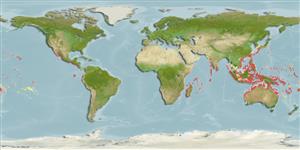Classification / Names
Common names from other countries
Main reference
Size / Weight / Age
Max length : 40.0 cm SL male/unsexed; (Ref. 54980); common length : 25.0 cm SL male/unsexed; (Ref. 9843)
Length at first maturity
Lm ?, range 22 - 23.6 cm
Environment
Marine; brackish; reef-associated; depth range 0 - ? m
Climate / Range
Tropical, preferred ?
Distribution
Pacific Ocean: ranging eastward to the Gilbert Islands and Samoa, north to southern Japan. Confused with Hemiramphus archipelagicus under the name Hemiramphus marginatus by many authors (Ref. 10943).
Countries | FAO areas | Ecosystems | Occurrences | Introductions
Short description
Dorsal
spines
(total): 0;
Dorsal
soft rays
(total): 12-15;
Anal
spines: 0;
Anal
soft rays: 10 - 13;
Vertebrae: 52 - 57. Greatly prolonged, beak-like lower jaw; upper jaw short, triangular and without scales; preorbital ridge absent; total number of gill rakers on first gill arch 33-46; pectoral fins long, reaching beyond anterior margin of nasal pit when folded forward; no spots or vertical bars on sides.
IUCN Red List Status (Ref. 115185)
Threat to humans
Harmless
Human uses
Fisheries: minor commercial
More information
ReferencesAquacultureAquaculture profileStrainsGeneticsAllele frequenciesHeritabilityDiseasesProcessingMass conversion
Tools
Special reports
Download XML
Internet sources
Estimates of some properties based on models
Phylogenetic diversity index
PD50 = 0.5005 many relatives (e.g. carps) 0.5 - 2.0 few relatives (e.g. lungfishes)
Trophic Level
3.4 ±0.5 se; Based on size and trophs of closest relatives
Resilience
High, minimum population doubling time less than 15 months (Preliminary K or Fecundity.)
Vulnerability
Low to moderate vulnerability (30 of 100)
Price category
